Are you looking for a way to get tens and even hundreds of backlinks the right way without Google penalizing or devaluating your backlinks, then keep reading!
Guest posting, when incorporated as part of a well-structured link building plan, is arguably one of the best link building strategies to increase your ranking and website traffic if done correctly.
The traditional way of doing guest posting is no longer effective and the Google algorithm can quickly discover the obvious guest post and devalued the backlink resulting in barely getting any benefit you would normally get from a “natural” backlink.
And in this reading, I am going to share with you how to do guest posting or guest blogging the right way so Google doesn’t catch you and you get maximum SEO results from your guest posting, let’s get started:
What is Guest Posting?
Guest posting or guest blogging is a process of getting other prominent websites to publish your written blog post on their blog with DoFollow link pointing to your website in order to get link juice, thus increase your PageRank, website ranking, and traffic from search engine results pages (SERPs).
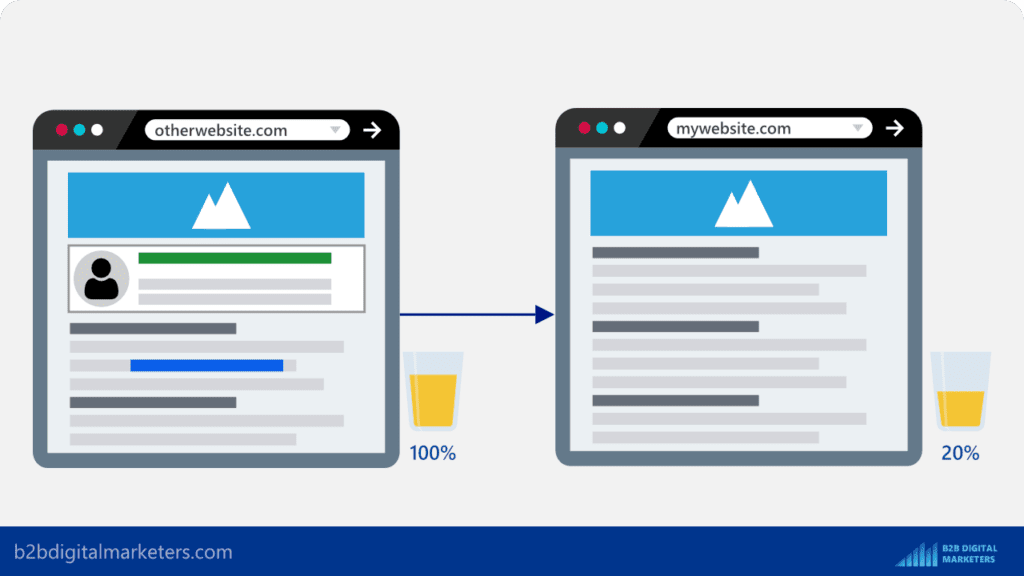
Guest posting, when supplemented with link building tools, becomes one of the easy link building strategies that is recommended by link building experts like Matt Digitty and used by link building companies to earn links for their clients quickly and easily.
Is Guest Posting Good for SEO?
Guest posting or guest blogging is great for SEO and one of the best ways to increase your domain authority or PageRank if it is done correctly and it brings one of the biggest link building benefits.
It is super beginner-friendly, and I recommend everybody to continuously search for guest blogging opportunities. Especially for those who are just starting out and need quickly to build high-quality backlinks.
Using a guest posting strategy helps you to acquire backlinks from other prominent websites. These backlinks are used by search engines to evaluate your website and are considered as one of the most important ranking factors when assessing your website for ranking.
Google itself even stated this on their website how they search for quality content:
For example, one of several factors we use to help determine this is understanding if other prominent websites link or refer to the content. This has often proven to be a good sign that the information is well trusted.
And many of the successful bloggers have used guest blogging to increase their website traffic, domain trust and to rank higher.
For example, Leo Widrich, the founder of BufferApp used the guest blogging strategy to acquire 100,000 customers in just nine months. He wrote around 150 guest posts.
Another great example is Brian Dean that published over 200 guest posts and now he is ranking on top results for some of the most competitive keywords in the marketing niche and drives almost 500K organic traffic from search engines according to SE Ranking.

With that being said, you need to also know that Google does not like guest blogging, as said by John Mueller, guest posting for links results in unnatural links and he says Google already devalues them.
However, that does not mean guest blogging is over, you just need to be smart about it to ensure your guest post is not so obvious so it doesn’t get caught by the algorithm as the traditional way of doing guest posting is pretty obvious.
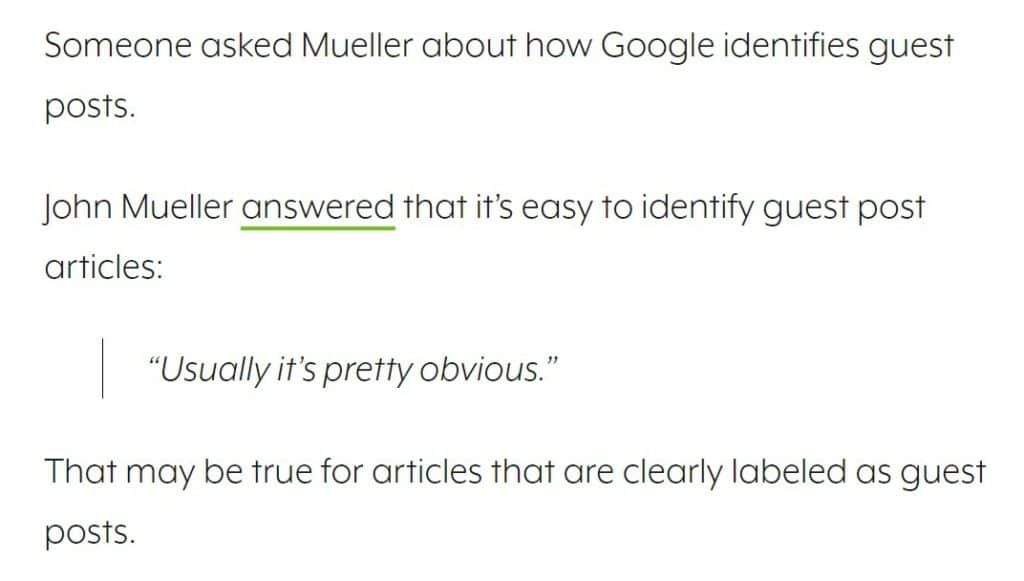
With that let me show you how you can become a guest blogger without being so “obvious”.
How Do You Become Guest Blogger?
As I said, there are a couple of things that you must do to not get caught by Google.
With that here is my 6 step process to increase your guest posting conversion rate, your SEO impact from guest posting and to not get caught by big G.
Step #1: Prospecting
The first step is to find guest posting prospects.
When it comes to finding prospects for your guest posting you want to avoid anything that obviously shows that website accepts guest blogging opportunities.
With that let me show you two famous techniques link building gurus recommend to use to find guest posting opportunities, but you should not use:
Technique to AVOID #1: Using Google Search Strings
This is by far the biggest guest posting and link building mistake where you use Google search strings to find guest blogging opportunities such as these:
Keyword + “submit blog post”
Keyword + “write for us”
Keyword + “submit news”
Keyword + “submit content”
Keyword + “submit your content”
For example, in my case it could be something like this:
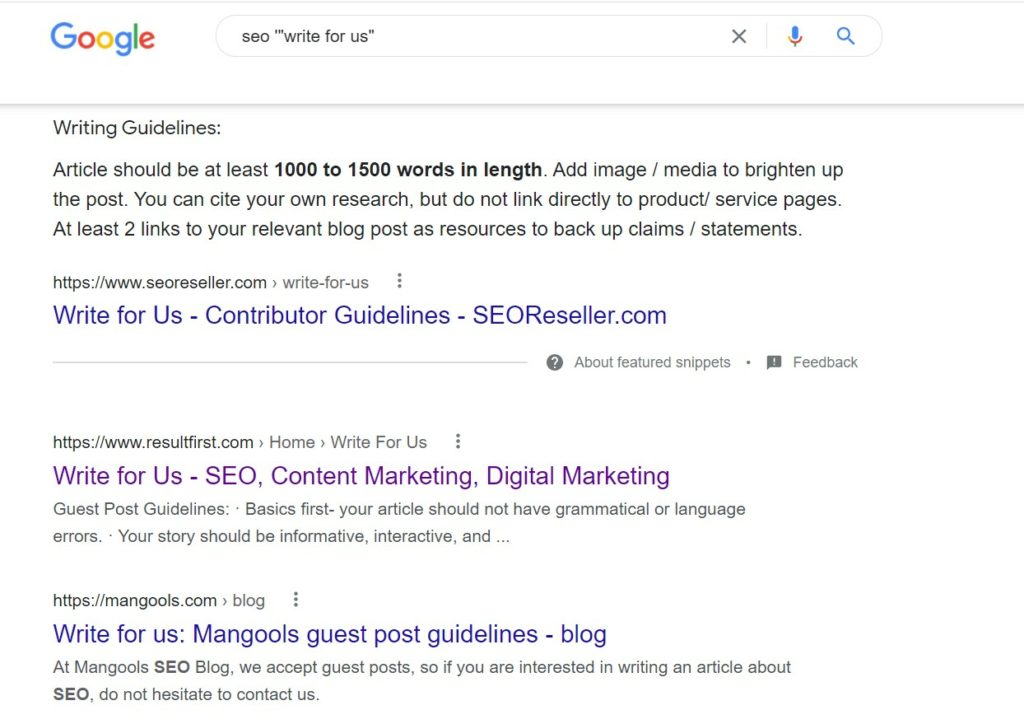
Of course, this is as obvious as it gets and Google will quickly devaluate any backlink you obtain from sites like these. Therefore, don’t waste your time searching for guest posting opportunities using this method.
Technique to AVOID #2: List of Sites that Accept Guest Posts
The second method you should avoid is to search for a list of sites that accepts guest posts.
Countless websites publish a list of sites that do accept guest posting on their website.
Just pop into Google something like this: “list of sites that accept guest posts keyword”.
For example: “list of sites that accept guest posts supply chain”
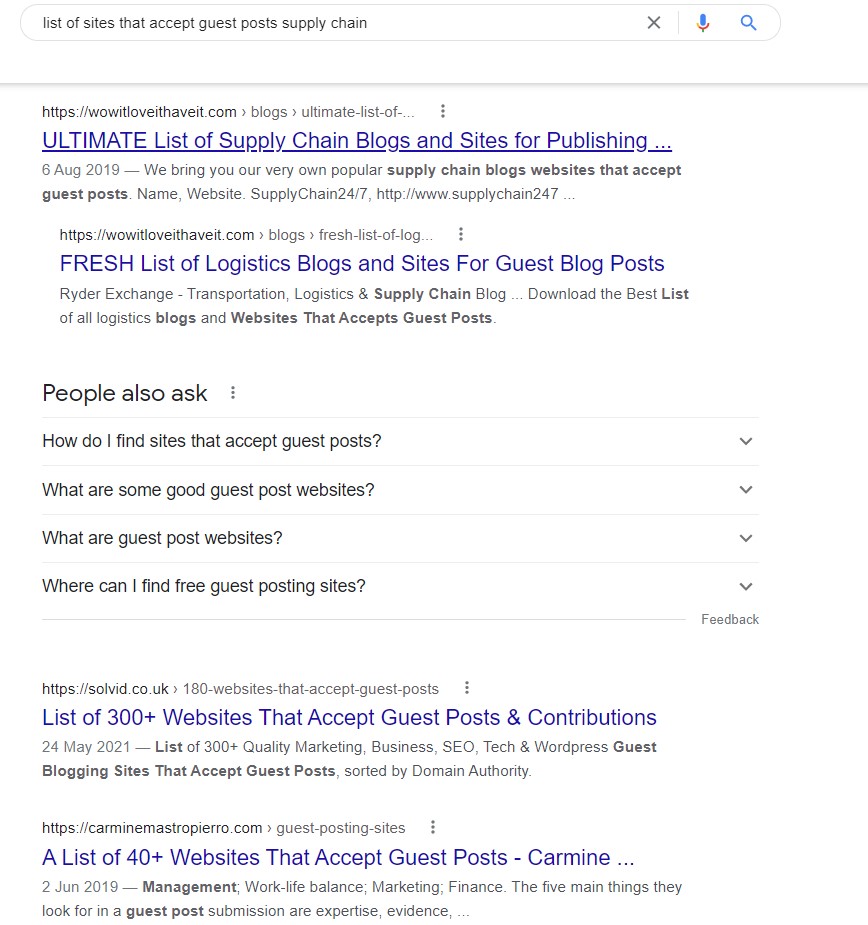
As you can see, countless opportunities are waiting for you.
Wrong! Remember, any guest posting site that you can find via Google search should indicate a big STOP sign for you and you don’t want to waste your time and resources for such sites.
With that, let me show you two techniques of how you should search for hundreds and even thousands of potential guest posting prospects quickly and easily:
Technique #1: How to Find Guest Posting Prospects
Finding prospects should not take you any longer, than just a few minutes or a maximum of an hour. Remember, finding prospects is just the first step, where you just want to get a large list of raw potential guest posting prospects, and later you will vet those prospects using the guest posting checklist.
With that let me show you how you can find hundreds or even thousands of prospects within your niche to build niche relevant backlinks.
Step #1: Open Competitor Research Tool, I prefer using SE Ranking. Enter your domain, select your targeted location, and click analyze.

Then, here I will get a high-level overview of my analyzed domain such as the organic traffic, domain trust, organic ranking keywords, and more.
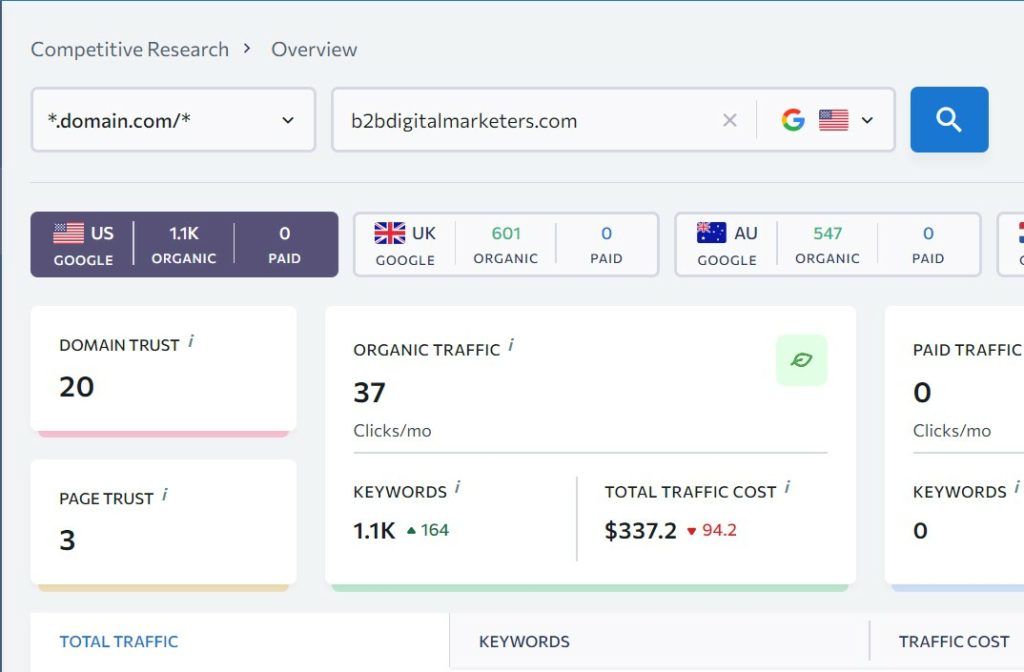
Now, I just select the “Competitors” report in the “Organic traffic research” section.

And here you will get a list of your competitors based on your ranking keywords. Of course, the more keywords you rank for, the better the suggestion is.

Now, if you want to expand your list with even more relevant suggestions, you can take the domain of one of your competitors and run the “Competitors” report on their domain to get a different list. I suggest you choose a competitor domain that is targeting mainly keywords within your niche.
For example, in my case, this could be the domain “backlinko.com” as they are only focusing on “SEO” and “Content Marketing” topics just like me.
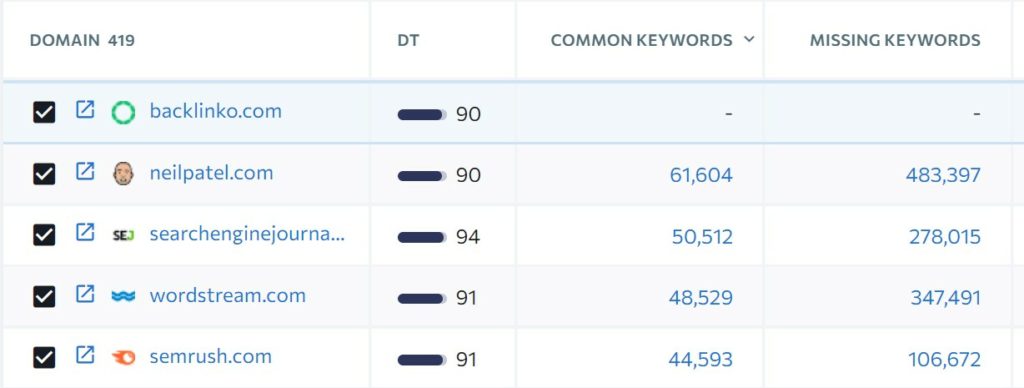
However, I would not run a “Competitors” report for a website such as “fool.com”.
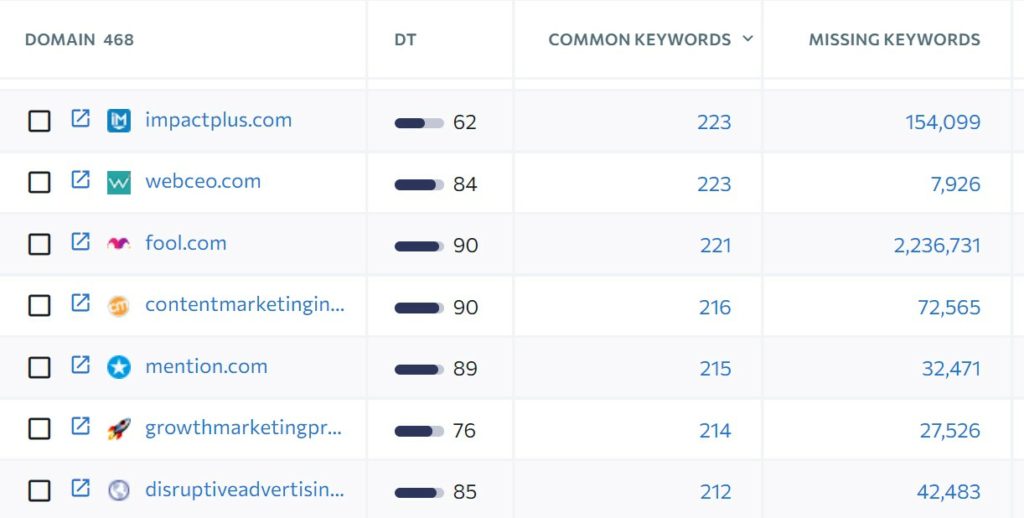
As they are mainly focusing on “Investing” and “Stocks” topics rather than marketing, even though it is between my top competitors. I don’t know why they are targeting “marketing keywords”.

Once I have selected my competitors for the “competitors” report to get even more suggestions, then I select the “export” option to a spreadsheet.

Typically, I select at least 10 competitors to get a nice list of potential prospects for guest posting, however for this tutorial let me do just five.

Now, I create one master spreadsheet and combine all of those domains into one spreadsheet which gives me over 2,000 domains.

Then I remove any duplicates and I am left with almost 900 domains. A raw list of potential prospects for guest posting that is ready to be vetted.
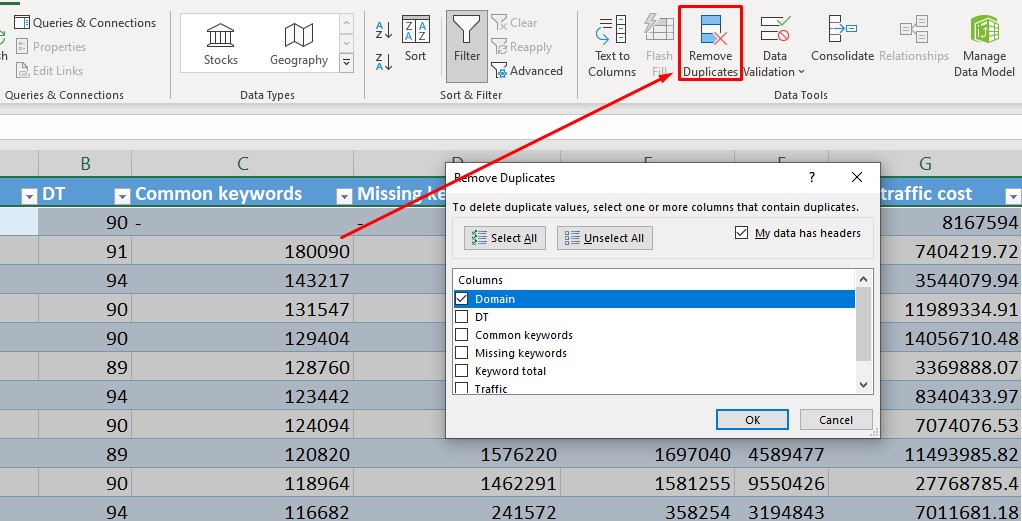
Technique #2: Export Google Results
The second technique works just as fine and you can get quickly hundreds of potential prospects for your guest posting.
Now you can use Google itself or your preferred SEO tool.
If you use Google Search you want to set the results page to 100.
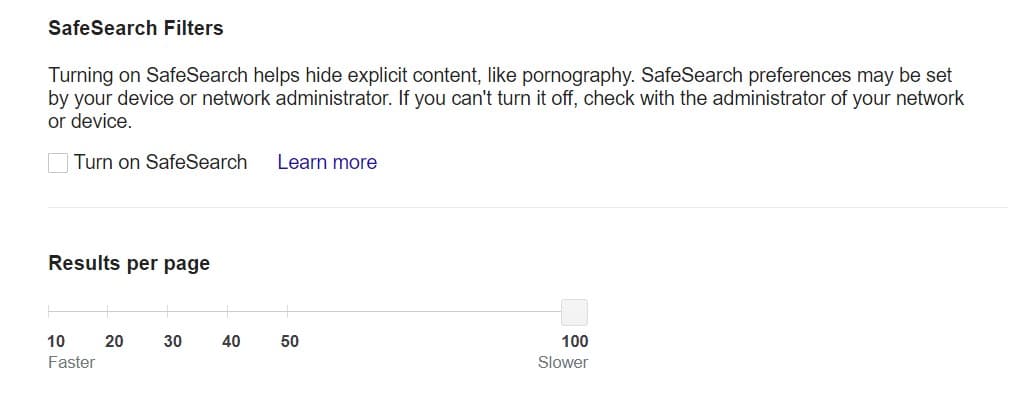
Then, you want to enter one of your targeted keywords and export the Google search results into a spreadsheet using a tool like SEOquake.

Or you can use your keyword research tools like SE Ranking, where you enter your targeted keyword, scroll down to the “Organic SERP” section, and export the domains here.
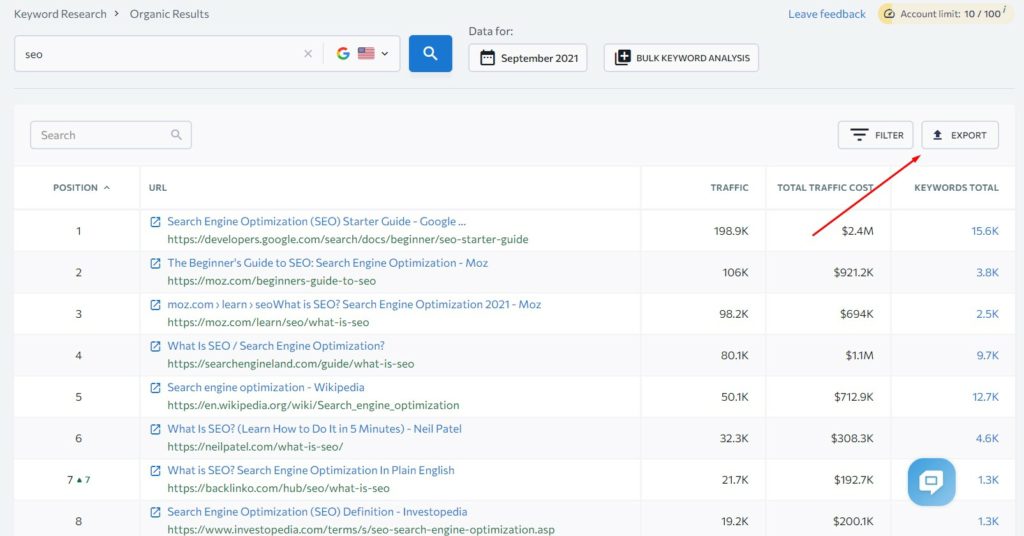
I prefer this method because you can get the exact results based on your targeted country without personalization like when you are using Google search.
Now, you can do this for 1 or as many keywords you want and you have a nice list of potential prospects.
Step #2: Vetting
Alright, once you have found your prospects, the next part is to evaluate your prospects to ensure you are not wasting your time.
Because publishing guest posts takes a lot of your time and resources, and you simply do not want to publish an article on low-quality sites, sites that get devaluated or will not move the ranking needle for you.
So here is a guest posting checklist that you should follow to vet good prospects from bad prospects:
Criteria #1: DoFollow Link
The first and the most important aspect that you want to make sure of is that prospect will provide a dofollow backlink within your guest blog post and it will not be marked as “sponsored” or “nofollow” as required by Google.
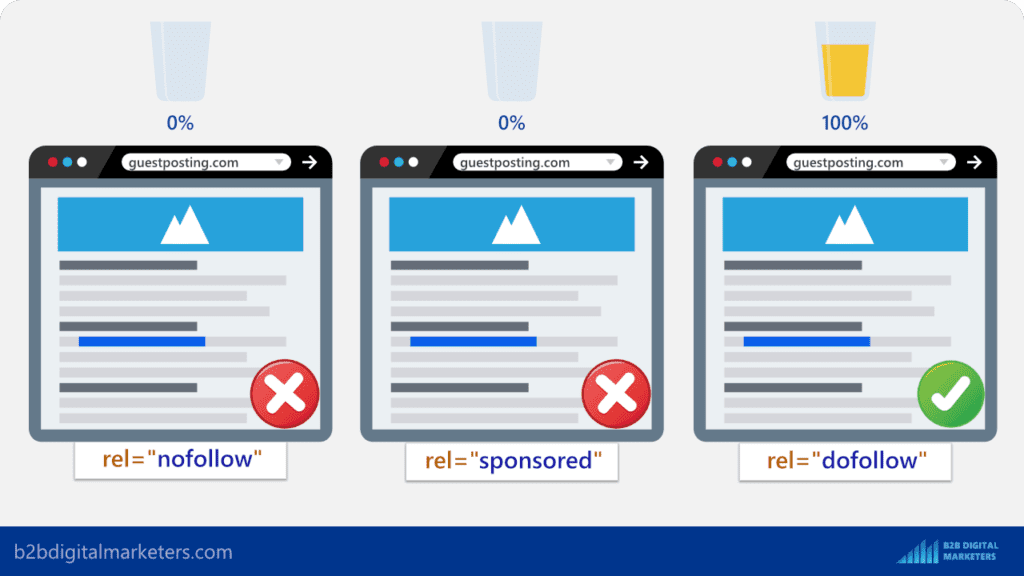
Because once links are marked as “nofollow” or “sponsored” Google will automatically not pass any PageRank, thus, you will not get any benefit of increasing your ranking and organic traffic from SERPs.
And even though, Google recently said, they will take “nofollow” link as a hint that might pass link juice if it is a natural link, but in this case, we and Google know that this is not the case. Therefore, you want dofollow link.
However, this will be checked during step #4 in the negotiation part, so let’s move on.
Criteria #2: Not Using Spam Trigger Words
The second criterion is your prospect is not using spam trigger words dominantly displayed on their website.
These spam words that trigger Google spam detector are often displayed in very visible places so guest bloggers can find it such as:
- “write for us”
- “guest blog”
- “guest blogging guidelines”
- “publish your article here”
- “submit your article”
- And many more
Any website that publicly displays that they accept guest posts will get quickly discovered by Google. I mean what is more obvious than this?
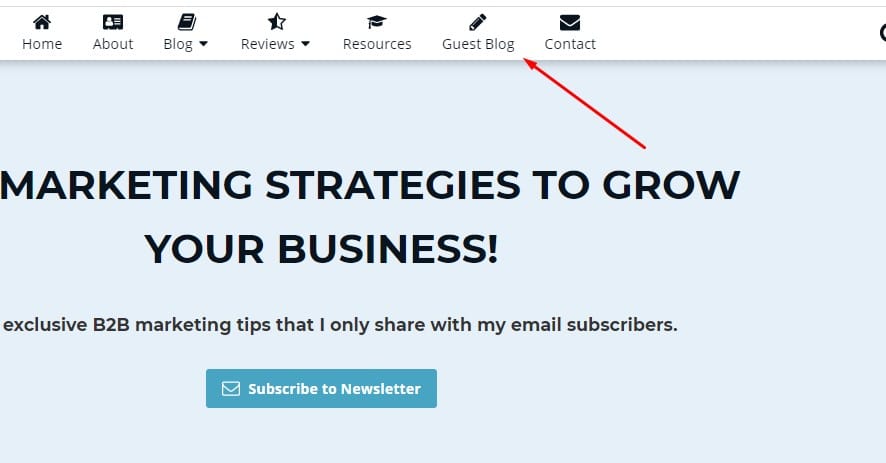
So, before you start reaching out to your guest posting prospects, you want to make sure, that they do not publicly display they accept guest posts.
Whether it is in the header, footer,

Or anywhere on their website. You don’t want to receive their web page with guest blogging guidelines that can be crawled and indexed by Google.
Their guidelines should be only provided in a word document, pdf, or similar not published document on a website.
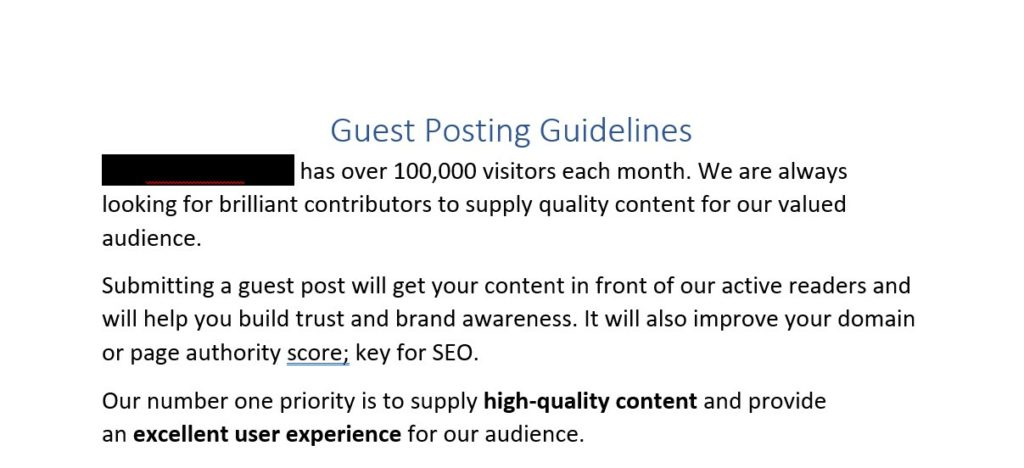
Criteria #3: Website Traffic
The third and very important criterion is website traffic.
Website traffic is very important to check to determine whether it is worthy to do guest posting for the domain or not.
The reason why is quite obvious. If Google is sending traffic to a webpage that means they already trust the website. If the domain does not get any organic traffic despite they are publishing content, that brings up a red flag to me.
Therefore, you want to make sure, the domains have at least some organic traffic.
How much?
This depends on many aspects. Some say at least 1,000 organic traffic according to your preferred SEO tool, in my case, it is SE Ranking.
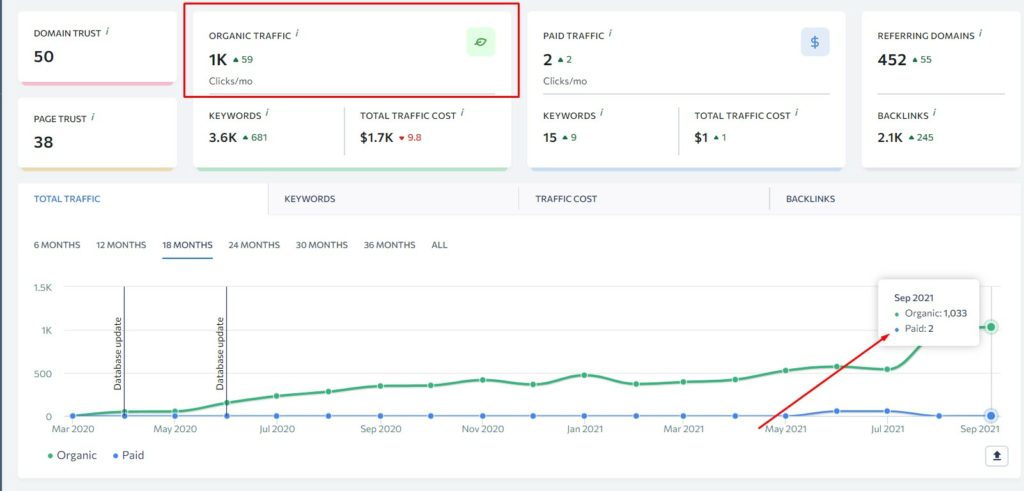
But for me, I am willing to go as low as 500 and still see great results, depends on the industry, location, website credibility, and link building history.

Remember, the higher the organic traffic, the harder it is to get your guest post to publish.
So for this, I can easily adjust my spreadsheet to remove any sites that do not meet the threshold 500<.

Criteria #4: Traffic Location
The third criterion that is very important is the traffic location.
This is especially important if you care about the location of your traffic, whether you are a local business, an affiliate site that earns money only from certain countries, or anybody that wants to drive website traffic from a certain country/ies.
Therefore, if you want to drive traffic from a certain country, then getting your guest post published on a website with predominantly website traffic from the country you want will help you to boost your local website traffic.
For example, if I am an affiliate site, that wants to drive or increase my traffic in Italy, then I would want to get my guest post published on this website.
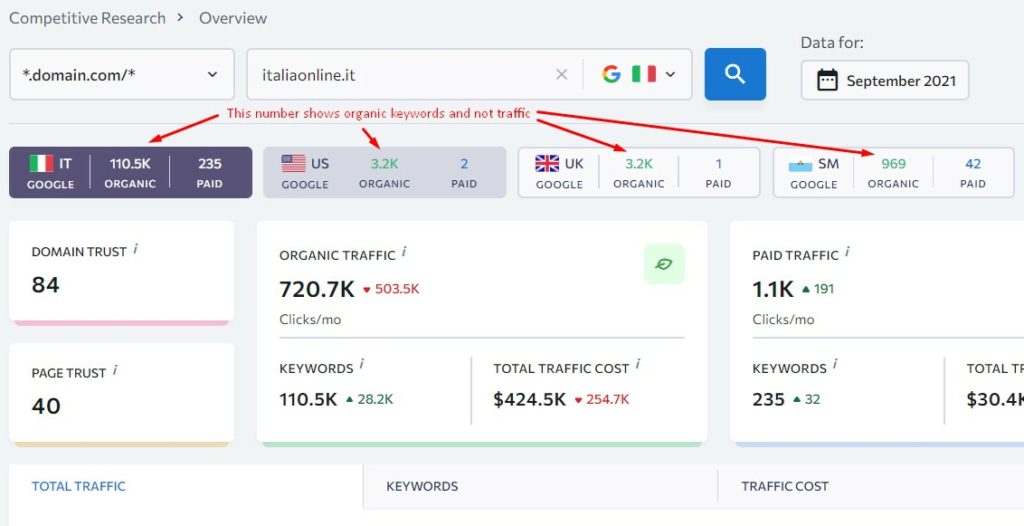
As you can see, the highest number of keywords the website is ranking for comes from my targeted location and when I switch between the country’s tabs, I can also see, their organic traffic mostly comes from Italy as well.

Thus, if the location of your website traffic is something important to you, then you want to prioritize those websites with the website traffic coming mostly from your targeted location.
Criteria #5: PageRank
The fourth criterion that you want to watch out for is the PageRank.
Now, because Google does not show PageRank anymore, there are SEO tools, that have developed their own algorithm to show estimated PageRank, and depending on the SEO tool you are using they call it differently.
For example, SE Ranking calls it a Domain Trust.
Definition:
Domain Trust is an aggregate domain quality score developed by SE Ranking. It is calculated based on multiple factors including the number and the quality of a website’s referring domain and backlink profile.
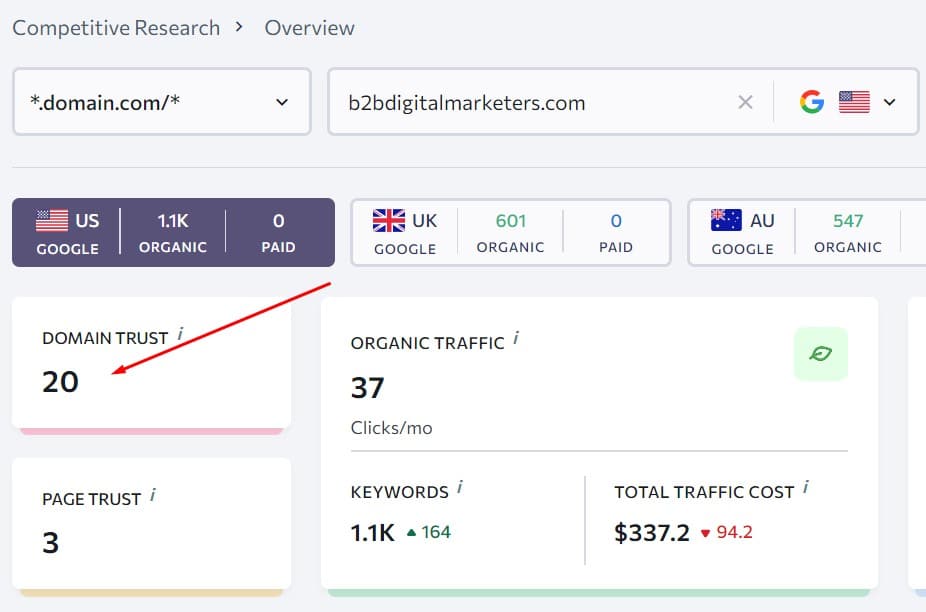
Now, based on this number you can estimate how much PageRank the website has and how much it will influence your ranking and website traffic if you get a dofollow link from a domain.
Obviously the higher the better, but the higher the domain trust, the harder it is to land the guest post.
So, what’s the minimum domain trust you should aim for? Typically recommended domain trust is around 20, however, going as low as 10 is fine if the website generates high traffic.
For example, a domain with a domain trust of 63, but organic traffic of only 500 will have a smaller influence on your ranking,
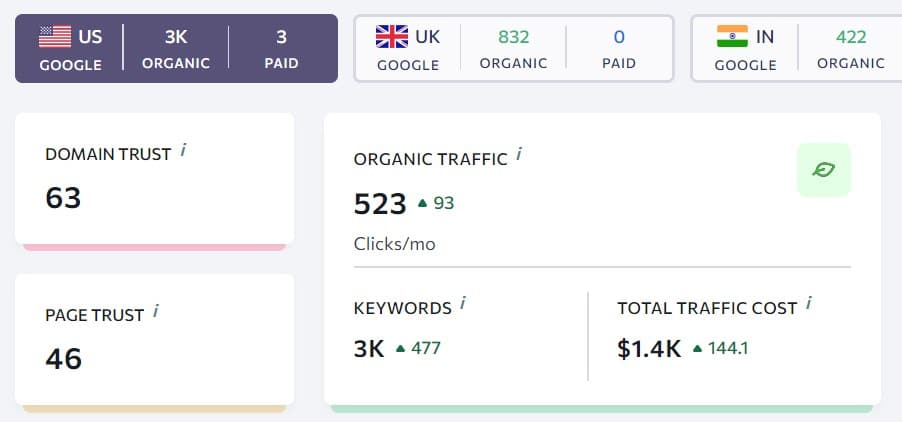
then a domain with domain trust only 32, but organic traffic almost 10,000. At least from my own experience, a combination of website traffic and domain trust often indicate the best potential of improving your SEO results.
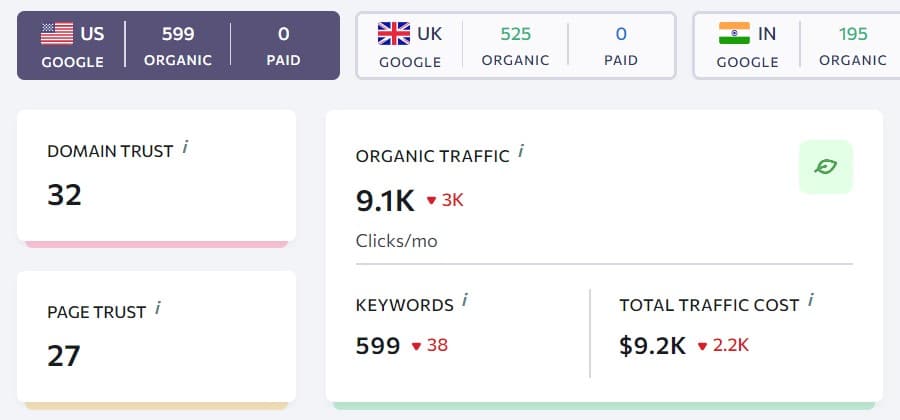
Criteria #6: Internal Links
Another important criterion for your guest posting is to ensure your guest post will get internal links once it is published.
Internal links are very important for your guest posts as that’s how your guest post will get the valuable link juice from other internal pages, so it can pass the link juice to your web page, thus increase your ranking and website traffic.

Therefore, finding if your prospects are properly connecting their blog posts with internal links will help you to determine whether you will get the valuable link juice love.
However, if not, then you can also help them, often assisting your prospects to find relevant internal links for your guest post will help you get the link juice and you will save their time.
For example, let’s say I have published a guest post article that targets the keyword “long-tail keywords”. So, to find any relevant internal links on my prospect domain I can use the Google search operator site:domain.com keyword.
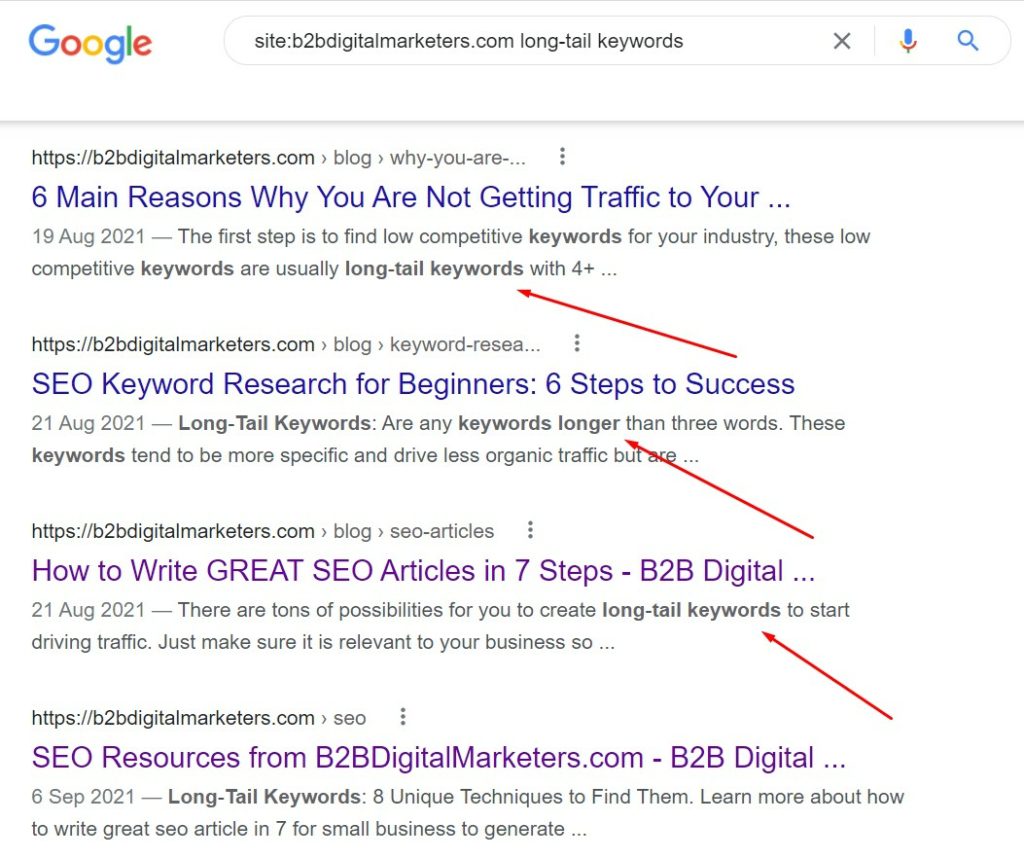
And this will help me to find any keyword mentions on my prospect website within just a few seconds.
Criteria #7: Relevancy
And the last important criteria for guest posting is the relevancy of:
- The domain to your niche
- The guest post topic
- The anchor text of your backlink.
So, let’s describe each of these what they mean.
The relevancy of the domain to your niche means a domain publishes articles on similar topics you are targeting. For example, I am in the SEO niche and I want to publish guest posts on the domain that write about SEO, content marketing, email marketing, or any similar niche topics in digital marketing.
However, as an SEO blog, I would not want to publish guest posts on a website that is about investing, real estate, and other topics that are not relevant to my niche.
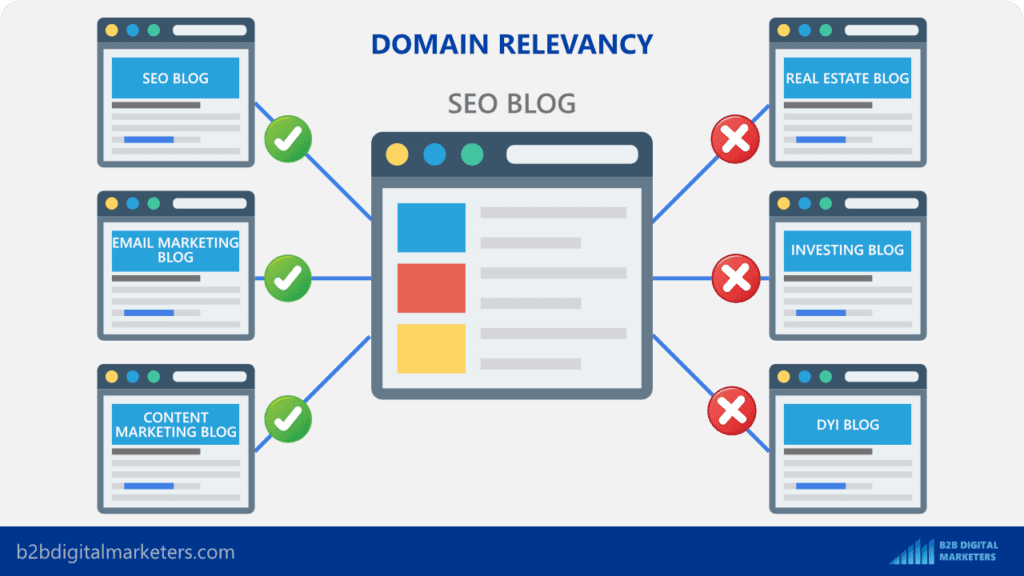
The topic relevancy is like domain relevancy, and it means the topic of your guest post. Essentially you want to get as close as possible to your niche.
The reasons why are because it is much easier to add a relevant backlink to your article that is on a similar topic and to optimize your anchor text.
For example, if you are in the SEO niche and writing guest posts about email marketing, then mentioning something about SEO to add a relevant backlink to your article with relevant anchor text can be difficult.
Of course, you can go even deeper and consider more things and add even more criteria, but at the beginning I recommend you focus on only these things. And once you build more experience and get the feel of the industry, then you’ll know better what blogs work the best for you so you can focus more on them.
Step #3: Outreach
The third step of guest posting is the outreach process.
At this stage, you will learn how you can find emails of the right people and get in touch with them, and then negotiate your guest post to get the best possible results.
So, let’s get started:
Part #1: Finding the Right Person and Their Email Addresses
The first step of your blogger outreach process is to get in touch with the right person.
Now, because you want to avoid any websites that publicly display their guest posting guidelines with an email like this one:
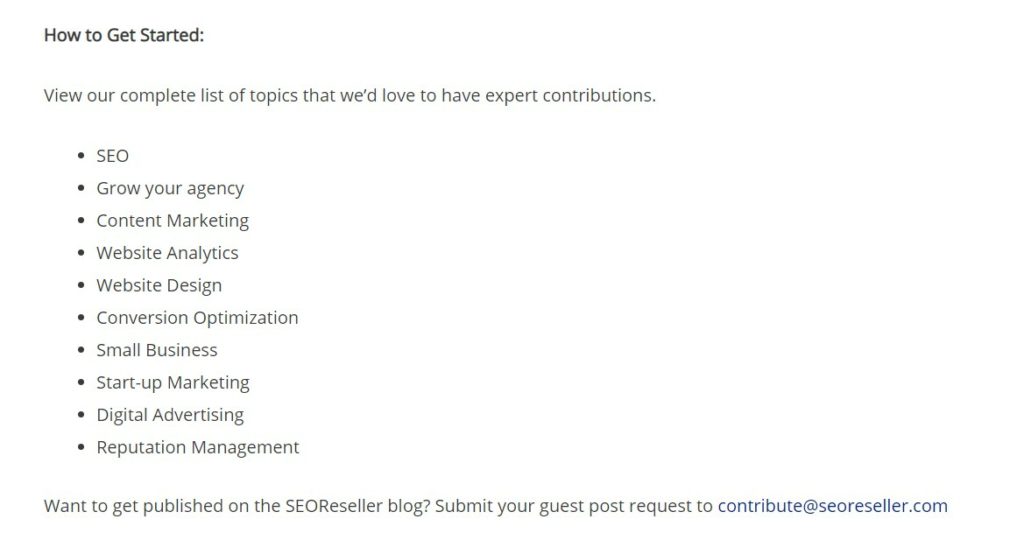
You need to find an actual email of a person in charge of the blog that would be interested. Sending an email to a person that is in charge of social media, email marketing, PPC, etc. will not do the work, as those people often will skip the request and very rarely pass it to the right person.
Therefore, you need to find the right person. To do that, there are a couple of ways:
Technique #1: Check out the Authors
The first technique to find the right person is to check in-house authors.
For example, let’s say I want to publish a guest article on the website blendb2b.com. So, I will go on their blog page to see who the authors of their blog articles are.

Now, let’s pick one of the authors and see if we can find who he or she is by using the power of Google.
And right away I found Phil LinkedIn and he is a director and co-founder of blendb2b.com, that’s what I am mean the right person!

Now, I need to find his email, but for this, let’s move to the second technique.
Technique #2: Use Hunter.Oi or Similar Tool
The second technique to find the right person and email address of the person is to use tools like Hunter.io.
This is a more efficient way of searching for email addresses at scale. Simply put in the domain of your prospect and you will get a bunch of emails.
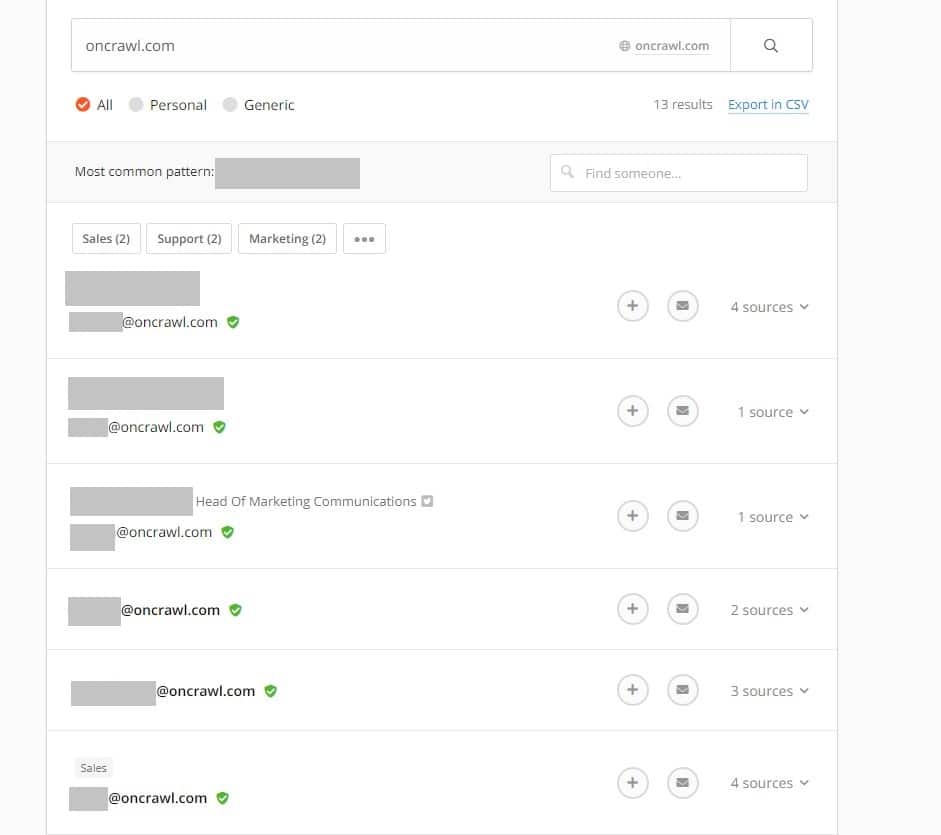
However, it does not always work.

So sometimes you need to search for a person or an author. Or if you used the first technique, then this is the way how you can find the email address of the author.
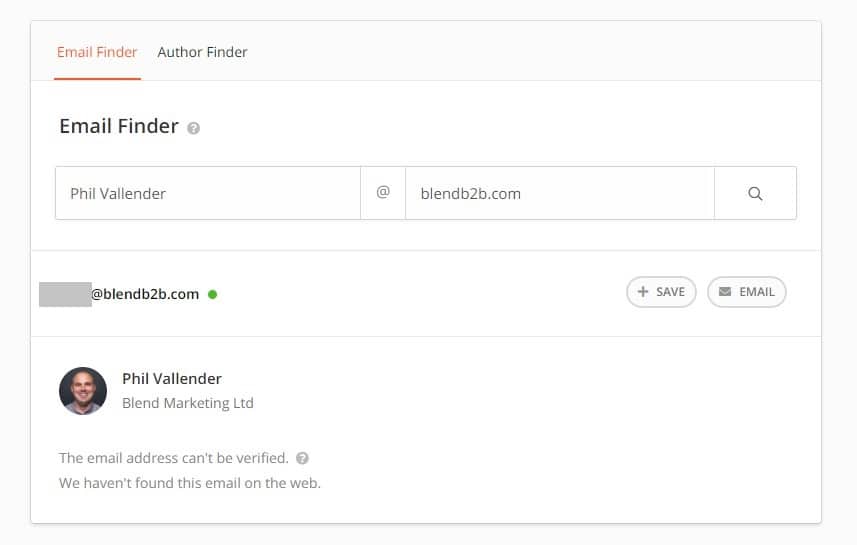
Other Techniques
Of course, there are other ways to find the right people like going on the company About Page and then finding their emails.

Or going on social media like LinkedIn and finding the right people there.
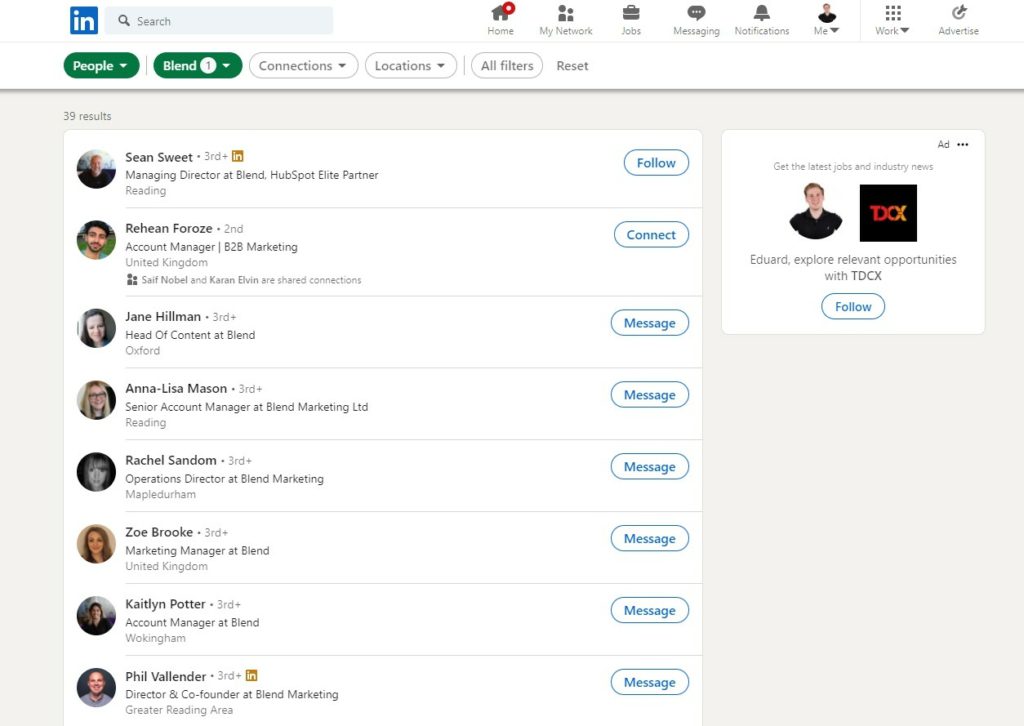
There are so many options to do that, however, to get their email addresses often you will need to use email finder tools like hunter.io.
Part #2: Content Gap Analysis
Once you have the right person or people and their email addresses, the next step is to run a content gap analysis.
Now, there are a lot of bad ways to get in touch with your prospects and ask them for guest posting opportunities such as this:

As you can see this is clearly spam, not personalized, topics have no targeting, and probably this was sent to hundreds or even thousands of email addresses and hope for best.
This is a shotgun approach that yields minimum to no results. Instead, you want to be personalized as possible, and to do that, you need to find the right person you want and the right topics they would want to target by doing a content gap analysis. Let me show you:
Step #1: Put your prospect domain in a competitive research tool, select the location and click on analyze. Then open the competitor report.
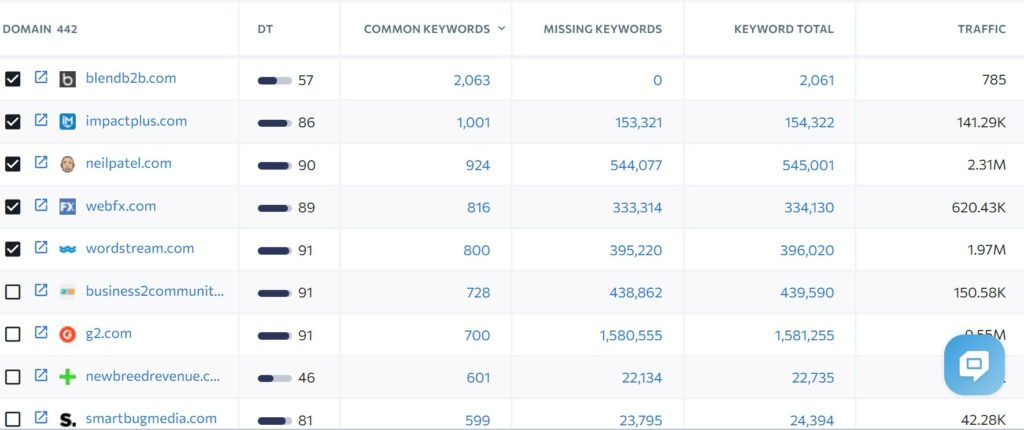
Here, you are searching for a close competitor that has way smaller DT (domain trust), yet high traffic and a high number of missing keywords like this one:

Here I will get a list of missing keywords the analyzed domain is not ranking for, but the selected competitor is ranking for.
I typically switch to the “Unique” tab and choose the selected competitor domain to see their unique keywords and ranking position.

Now, I only have to scan for the keyword list to see any relevant keywords that the selected competitor is ranking for in the top search such as the keywords “marketing in real estate”, “elementor WordPress”, and “advertising for real estate”.

These keywords are great, because if my prospect competitor is ranking high despite having low domain trust, then my prospect has a high chance to outrank them.
Also remember, you are searching for keywords where Google displays blog posts. You won’t and cannot pitch a keyword if Google displays product, service, or category pages.
Part #3: Getting in Touch
Alright, once you have your list of keywords, then you can start pitching to your prospects.
Now, this super personalized approach and you are offering value up front before you ask for anything in return.
You found keywords, that are valuable to your prospect, thus they for sure will want to rank for that keywords and because you already help them, they will be more willing to give you a shot to write a piece of content for them.
So now, you only have to write a personalized email to the right person to get their attention.
Here is my proven template that I use every time:
Hey [Name]
I’m [Your Name] and I have done content gap analysis for your website and found that your competitor [competitor domain] rank in top positions for keywords:
- [Keyword #1]
- [Keyword #2]
- [Keyword #3]
But your website doesn’t. And we both know that these keywords could be valuable and drive you extra exposure and potential leads.
Now, based on this I know you will need to create content to target these keywords/topics soon or later to rank for those keywords. So why not now and why not me?
There is nothing you can lose if you do not like my content and you can keep the keyword ideas and send it to your writers to create better content.
How does it sound? Let me know if that is something that interests you.
Cheers,
[Your Name]
As you can see, I am very personalized, I have done my research, and before I am asking for something I am providing them value by showing valuable keywords they should target.
Remember, before you ask for anything, first offer value. This will rapidly increase your conversation rates and get you guest blogging opportunities even on the most authoritative website.
Step #4.1: Negotiate
The fourth step version. 1 is to negotiate your demands.
The first version of step #4 is when a prospect reply to your email and is happy to collaborate.
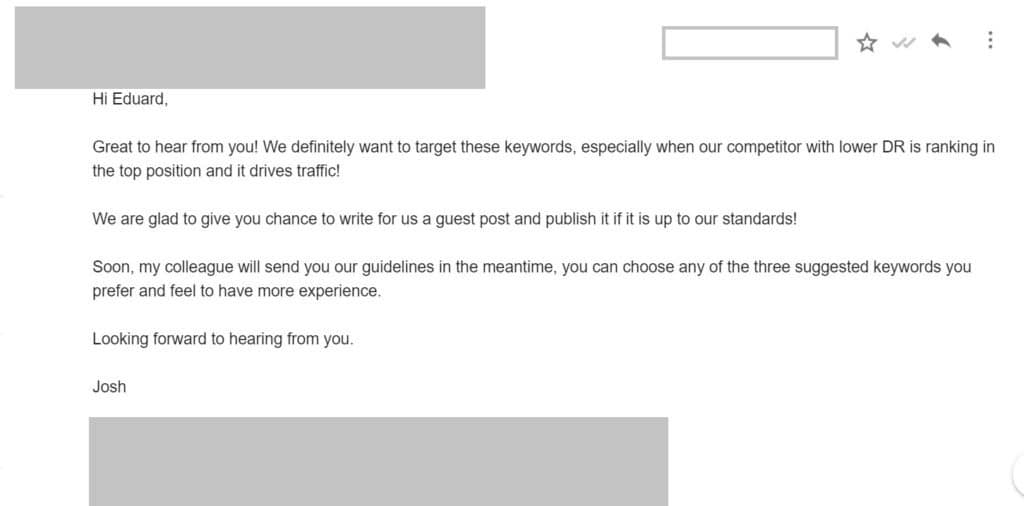
If you receive something like this, then obviously, the train has stopped and your destination backlink has been canceled, sorry for any inconvenience.

So, when you received a positive response to your proposal, then it’s time to negotiate your backlink requirements. Remember, you want to get backlinks in the way that seems the least “obvious” to Google that this is a guest post.
This means you don’t want a backlink that is:
- In the author box.
- Nofollow or sponsored.
- At the end of the article in the conclusion section.
Instead, you want a backlink that is:
- Contextual backlink within the text, somewhere in the first half of the article.
- Optimized with anchor text
- Or avoid any disclosure
I also like to inform my prospect beforehand about the backlink destination and potential anchor text. Of course, as I will write this might change, but generally, I match the anchor text within the context of the article.
So here is my negotiating template:
Hi [name]
Thanks so much for your response, super pump to write for your blog! I saw the guidelines and [everything is clear as a day] / [I have few questions].
[state your questions if so]
Also, before I start writing the article, I want to just double-check with you.
Are you okay if my guest post will include:
- 1-2 dofollow backlinks to my articles
- [article name + URL] with anchor text [anchor text]
- [article name + URL] with anchor text [anchor text]
- Not disclose me as the author
These articles and anchor text are just suggestions. Let me know if you are okay with it.
I am alright if you want to publish the article under your name or one of your writers and I give up my rights, ownership, and any association to the article. Only I wish to keep the backlinks.
Best regards,
Eduard
Now, this is a very rough template as your negotiation depends on their guidelines and the way how they respond. Also, you will come back and forth with them. However, I do believe you get the idea.
Step #4.2: Follow Up
The second version of the fourth step is if your prospect does not respond to you, then you need to write follow up email.
In most cases, this is what will happen, and you will need to follow up with your prospects. The good news is, if you do it right, you can increase your response rate between 20-50% from my experience.
Now, there are a lot of ways to follow up with your prospect, but you don’t want to be the guy that follows up like this:

I do admire persistence, but not in this way and like this, you will burn the chance to build any future bridge. So, if your prospect does not respond to your follow-up, just move on.
Remember, just because your guest posting prospect did not respond to you, it doesn’t mean, you cannot try it again in the future in a year or so.
However, for now, this might not be their priority, or they are too occupied with other stuff.
With that being said, here is an example of my follow up email for guest posting:
Hi [Your name] here again. Just a quick follow up on my proposal to write a guest post on any of these keywords:
- [Keyword #1]
- [Keyword #2]
- [Keyword #3]
If you don’t find these keywords relevant, let me know, I have a lot more relevant keywords that you might be interested in based on the content gap analysis of your domain.
Or if you are busy and this is not your priority, no worries, I hope we can collaborate in the future.
Cheers,
Eduard
As you can see, this is a short email, straight to the point. I also double-check the keywords in case they don’t like them.
Or if they are just too busy or not interested, I understand that too and still I am being open for future collaboration.
And if they respond to your follow-up email, then you can follow step #4.1.
And if they don’t respond, then just move on to the next prospect. I guarantee if you connect with at least 50 prospects and follow my steps, you will get enough opportunities for publishing your guest post.
Step #5: Publishing Guest Post
The fifth step is to publish your guest post.
Now, I won’t teach you here how to write an SEO article, however, let me share with you some of the common situations that might cause your guest post disapproved:
Situation #1: Didn’t Proofread Your Guest Post
The first situation that you should definitely avoid is you didn’t proofread your guest post and just submit it. Oh boy…
Before you send your guest post, always make sure you proofread it. The best scenario is when somebody with great English and topic experience can do that. I often hire somebody on Fiverr to help me proofread my guest posts and check all my data, claims, etc.
However, if you don’t have access to get someone to proofread and check your guest post, make sure to check it twice at different days and not twice in the roll.
Situation #2: Using Stock Photos
Another very common situation that often can cause your guest post to not be accepted is due to using stock photos.
Using stock photos in articles was cool about 15 years ago. Now, everybody can recognize whether you are using stock photos or original pictures, which makes your blog article look not very professional.
Studies show that original photos saw a nearly 35 percent higher conversion rate than the page with the stock photo and users have a positive experience with original pictures despite the poorer quality.
Remember, the most important thing about using pictures is the relevancy and the context. Just dumping a picture for sake of SEO won’t work.
Situation #3: Not Optimize for SEO
The next important situation that you want to avoid when sending your guest post to your prospect is your guest post is not optimized for SEO.
Remember, just because it is a guest post it doesn’t mean you should not optimize it for maximum SEO impact.
Just like with your blog article, you want to make sure, that it gets maximum exposure in search engine result pages (SERPs).
This means you want to optimize your guest post for:
- Primary keyword
- LSI Keywords
- Including SEO optimized pictures
- Using heading and short paragraphs
- Content length
- And everything there is to blog SEO.
Remember, every article is either liability or an asset and if the article has no potential to generate traffic, then there is no point in having it on a website.
Situation #4: No Longer Interested
Another situation that might happen and probably the worst of all is that they are no longer interested for some reason.
Unfortunately, this will happen from time to time. Sometimes they will tell you a reason why and sometimes, they will ghost you.
Either way no need to worry, you can always pitch your guest post somewhere else or publish it on your website if the primary keyword is relevant to you and you are not targeting it.
Summary for Step #5
Remember, posting guest posts is just the same as posting blog posts on your own website. You create your own feature picture, graphics, and pictures, optimize it for SEO, etc.
Also, try to add few internal links from your prospect domain, this might be hard, but at least a few show your professionalism.
Step #6: Scaling Up
And the last step of doing guest posting is to scale it.
As you can see guest posting can take a lot of time. And while at the beginning you will have to do everything alone, later you should think about scaling this process to generate more high-quality backlinks.
Because without and doubt guest blogging is one of the best link building strategies to get backlinks for your website, but it also takes a lot of your time.
So here is, my three tips to scale your guest blogging:
- Outsource prospecting and vetting steps: These are the easiest steps and can be easily outsourced by freelancers using platforms like UpWork or Fiverr.
- Outsource email finding: If you do not have tools like Hunter.oi you can easily outsource that too. Often freelancers have more of these tools. So, send the vetted list of prospects so they can add the email addresses there.
- Outsource writing the content: Also, you can outsource the actual writing as well. But avoid using cheap content writing services. Instead, you want to find an actual blogger who knows your industry and has experience in writing content for the industry. This is super important because low-quality content can damage your reputation and it’s hard to regain it back.
So, these are my tips to start scaling guest blogging.
However, I do not recommend outsourcing the outreach process as it should be done in-house as that’s when you are building a relationship with the brand or person and this could be a sure way to burn the bridges if don’t wrong.
Also, scaling your guest posting process often comes much cheaper than hiring an actual link building agency that will take care of everything for you. This is especially useful for smaller businesses with a limited marketing budget, yet still, need to get backlinks at scale.
Additionally, you should also know how to track backlinks to ensure you do not lose these hard-earned backlinks.
Best Practices for Guest Posting
Over the years of doing and helping with guest posting, I have learned some tricks and tips to increase my conversion rates, the qualify of my content, and the SEO impact I get from each guest post.
So here are some of the best practices for guest posting:
Practice #1: Help with Internal Links
The first best practice for guest posting is to help with internal links.
Google uses internal links as a way to better understand the importance of a web page. Thus the more internal links your guest post have, the higher the page can rank.

This is especially important because internal links help to pass the link juice to your guest post making it rank higher in the SERPS.

And because of that, your guest post will have more link juice to pass to the web page you have linked to within your guest post, thus maximizing the SEO impact from your guest posting.

Practice #2: Don’t Overoptimize Anchor Text
The second important practice is to not over-optimize your anchor text.
Google is looking at your anchor text to get a better context of the link and the page, therefore using keyword-relevant anchor text helps you to better rank for the keyword you are targeting.
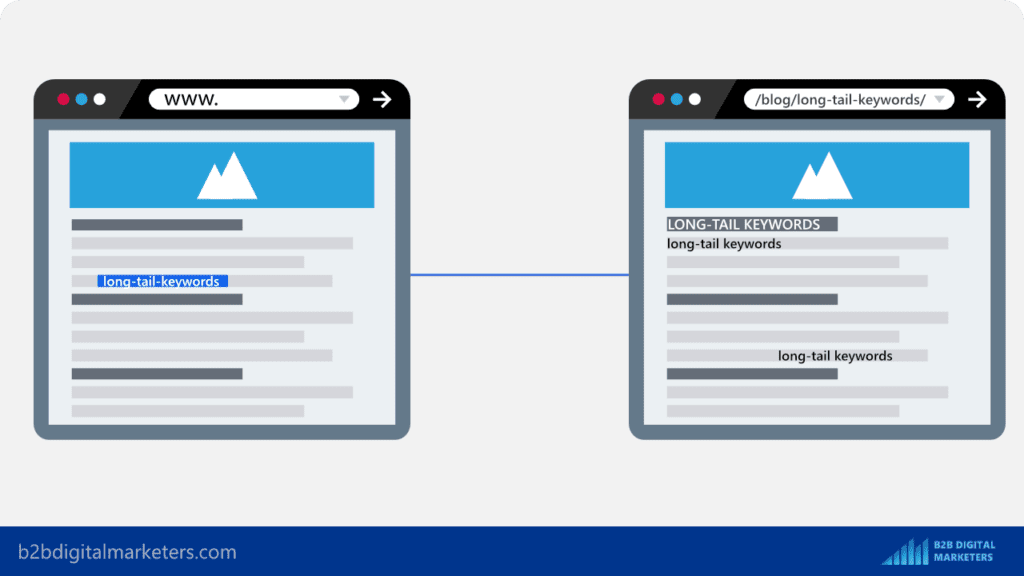
However, this is a double-edged sword, because if you optimize every single guest post for rich-keyword anchor text, then you will trigger the Google spam detector as getting always perfect anchor text seems fishy.
Therefore, you don’t want to always optimize your anchor text with rich keywords but changing it up.
For example, if I start a guest posting campaign and I want to get backlinks to my blog post about long-tail keywords, then I would change up the anchor text to make it look more natural with anchor texts like:
- Long-tail keywords,
- Easy to rank keywords,
- Longer keywords,
- Keywords with 3+ words,
- Sentence keywords,
- Keywords with many words,
- Don’t forget to target these keywords, etc.
Not only I will make sure to not trigger Google’s spam detector, but I give Google extra context about my page and more keyword ideas that are relevant to my article.
Like this, I can increase my ranking for my primary keyword “long-tail keywords” and for LSI keywords as well.
Practice #3: Outsource the boring
The third practice is to outsource the boring.
At first, guest posting might be exciting, but it gets quickly repetitive.
Therefore, you want to outsource the less important, tedious tasks that can cost you a few dollars but save you hours or even days of your life, so you can focus on more important things.
Typically, when I am starting a guest posting campaign I outsource prospecting, vetting, finding the right person and their email addresses as a first thing when I can afford it.
I just instruct the freelancer on Fiverr or another platform, just like I did to you here, and let him do his work. Within a few days, I have a typically clean list of prospects with all the information and I can start getting in touch with the prospects.
Here you can see the spreadsheet template I typically send to freelancers to fill it up:

Usually, I request for the column:
- Domain:
- Domain Authority: Based on the tool they are using.
- Organic Traffic: The estimate of organic traffic based on the SEO tool.
- Contact Person Name: At least two relevant people from marketing if possible.
- Email Address: Always to relevant people, not any generic email addresses like sales@domain.com or contact@domain.com.
- Job Title: I ask freelancer only to prove it is the right person.
- LinkedIn profile: Only if they cannot find an email address and the website has high value.
And later if you have the budget, then you can also outsource the content gap analysis part. However, I found that if you want to get great and relevant keyword suggestions you need to get experience SEO which can become a bit more costly.
Practice #4: Pitch Your Downloadable Content
Another great practice that I got from Brian Dean is to pitch your downloadable content.
Now, this not always works as you need a domain with:
- High authority
- High organic traffic
- Relevant downloadable content for the topic
On top of that, the prospects are not always keen to allow this as they often will want to promote their own downloadable content if they have.
Yet, if you strike a suitable domain and you have relevant downloadable content at your hands, then it can be a great way to get more subscribers.
Practice #5: Don’t Focus On the Most Authoritative Websites at First
Another thing I want to share with you. Don’t focus on the most authoritative websites on your list as a first and rather you should aim for the mid-range.
The reason why is because the high authority websites are probably bombarded by guest bloggers every single day which makes it very hard.
That is why first focus on the low and mid-range website to get some quick and easy wins and once you have some proof of your guest blogging experience, you can start targeting the more authority websites.
Practice #6: Build Relationships
And the last and arguably most important guest posting practice is to build relationships with the brands and website owners.
Building great relationships with the brand or domain owner can bring you more opportunities and benefits in the long run, than just publishing your guest post and disappearing.
For example, almost two years ago I published a guest article and since then I have stayed in touch with the person exchanging ideas and experiences.
And recently the same person contacted me, that he change the workplace and if I want, I can publish a guest post on their website and he even gave me a list of keywords to choose from.
Or another example is my partnership with SE Ranking, which started with me contributing to their guest post. And ever since I have had a great relationship with them and I am super happy to have the chance to offer their SEO platform to my readers and viewers.
Building relationships is always what you should be seeking when you are getting in touch with your prospect and backlink should be the second thing. Trust me, it will do better for you.
Final Words
Guest posting is arguable the best link building strategy for beginners to improve their ranking and website traffic, while not breaking the rules if done correctly.
If you will follow my steps, then you will see better conversion rates, higher SEO impact, and most importantly you will stay off Google’s radar.
Remember, if your guest post will be too obvious it will get devalued.
Related Articles:
- How to Write SEO Content: Learn How to Rank #1 in Google
- How to Do a Content Audit for B2B Website? To Increase Organic Traffic, Leads & Ranking
- Ultimate On-Page SEO Guide for Non-SEOs to Boost Organic Traffic & Ranking
- Off-Page SEO: Learn Everything You Need to Get Started in 2022
- B2B SEO Strategy for 2022: 8 Steps to Effectively Generate Leads and Organic Traffic
Also, check out our SEO hub page to find all our SEO resources.
Disclaimer
This article was created by Eduard Dziak and may contain affiliate links. The following were used to optimize the article for the best user and search engine experience include:
- SE Ranking for keyword research and on-page SEO optimization
- Surfer SEO for SEO-friendly content creation for users and search engines.
- Jasper AI for grammar correction and information enhancement.
The article is based on the author’s own experience and knowledge, drawn from both their own work and that of their clients, to provide the latest, proven methods.








